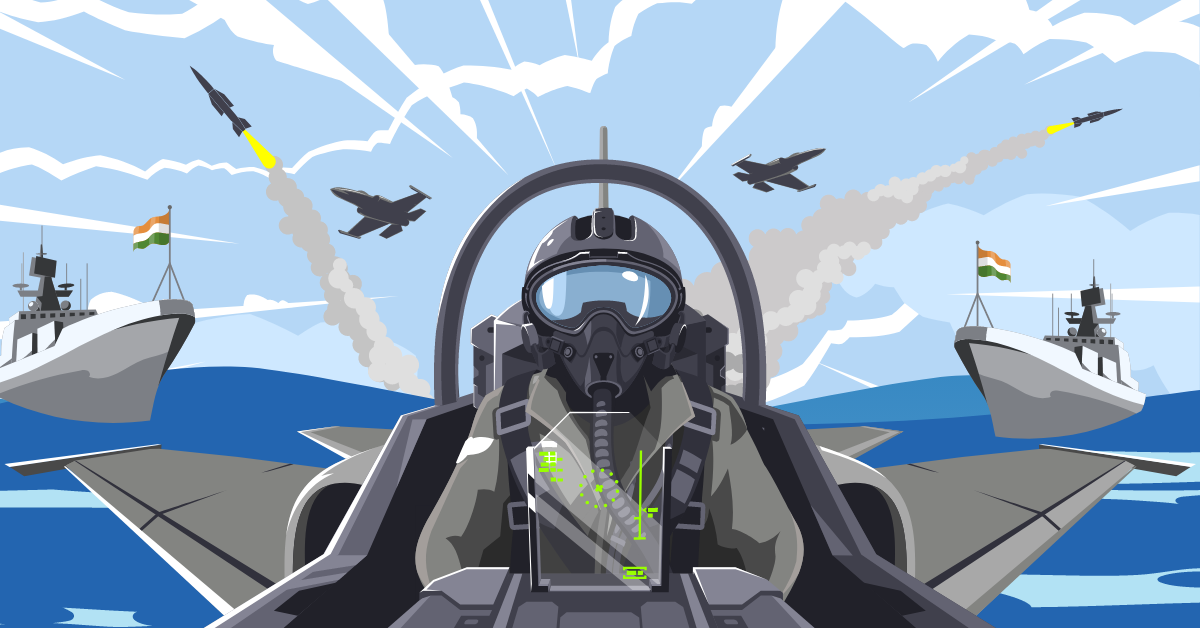India’s defence needs?
India is located geographically at a very strategic
position with vast borders covered by the salty waters
of the Indian ocean on three sides and by the great
Himalayas in the north, providing our country with a
natural shield. But some of its long borders are also
shared by enemy nations with nuclear capabilities, so in
order to shield its boundaries against any intrusion and
threats, its defence and security needs are also very
high.
Historically India spent approximately
2-4 % of its GDP and more than 10% of its annual budget
on defence. This makes India 3rd largest country in
defence spending after USA and China.
Source: World Bank, SIPRI
How much money is being spent by the defence forces?
As per recent data, the total outlay of India’s defence
budget stands at approx ₹5.25 Lakh Crores. Of this
Indian Army gets approx 58% share, Navy gets 16% share,
Air Force gets 19% share while other Paramilitary forces
get approx 6% outlay.
For modernisation purposes,
of its individual budget Army spends approx 8%, Navy
spends 54% and Airforce spends 52%.
Most of this money goes into procuring
defence equipment like
aircraft,
missiles,
platforms, etc. As India doesn’t have the indigenous capability
to manufacture most of this equipment due to lack of
technology and expertise in manufaturing; hence, most of
the equipment is imported from foreign countries with
expertise in producing them.
Who are the largest defence equipment exporters to India?
Historically Russia has been the largest defence partner
to India but due to the recent Rafale deal, France has
become one of the top contenders for the spot. So
Russia, France and the USA are India’s biggest suppliers
of arms, accounting for 46%, 27% and 12% of the
country’s imports in the last five years
SHARE OF DEFENCE IMPORTS TO INDIA BY
COUNTRY
Source: Statista
Government Intervention in the sector
Government of India has acknowledged this problem and
has allowed FDI in defence sector by first raising the
cap from 26% to 74% through automatic route and 100%
through MoD’s approval so that manufacturing and
technology transfer can take place. To support this
cause further, a negative import list of 209 items has
been created, which are not allowed to be imported.
These items include artillery guns, assault rifles,
corvettes, transport aircraft, Light combat helicopters
(LCHs) and even wheeled armoured fighting vehicles
(AFVs).
This move has benefitted domestic
companies, and the import of defence equipment is seen
to be declining steadily over the last few years, saving
India significant forex reserves and boosting domestic
competitiveness for manufacturing these products.
Source: PRS, MoD
Way forward
India’s defence needs are not going to reduce anytime
soon and with the government’s push to become more
reliant on indigenous production capabilities, companies
in this sector may do well. Many defence related PSU’s
and private listed companies have already benefitted
from the sector’s growth in last few years and more
companies are eager to participate in this sector.
| BENEFICIARY COMPANIES | RETURNS (1 year abs, as on 24th Jan 2023) |
| MAZGAON DOCK | +197.28% |
| GARDEN REACH SHIPBUILDERS | +117.97% |
| BHARAT DYNAMICS | +107.78% |
| HINDUSTAN AERONAUTICS | +85.17% |
| DATA PATTERNS | +67.69% |
| BHARAT ELECTRONICS | +53.11% |
| COCHIN SHIPYARD | +49.93% |
| L&T | +17.2% |
Recently a statement was given by our
hon’ble Defence Minister in the 95th Annual Convention
of FICCI in which he said that,”Government is working
and committed to increasing the defence production
target from current $12 billion to $22 billion by 2025.
You (industry) can imagine, with this kind of growth,
how many opportunities will be available for the Indian
industry”, assuring complete policy support to the
sector in the time to come.
Recommended
WealthBasket to participate in Defence theme :
Monopolies by Rupeeting


















